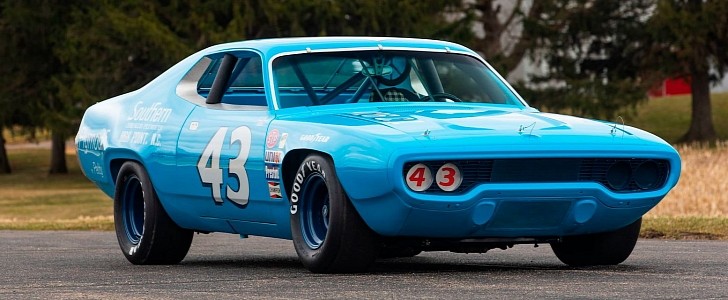1971 was a glorious year for NASCAR legend Richard “The King” Petty. His fourth straight Grand National season with a different racecar translated into a championship win as well as victory at Daytona, and this fellow here is the factory-backed racer that made everything possible.
The successor to the winged warrior known as the Superbird, the Road Runner is “the last stock car to win a Grand National championship using a production-based body and engine.” Delivered as a body in white to Petty’s shop, the Mopar icon scored 21 race wins and 38 top-five finishes.
Estimated to fetch between $500,000 and $750,000 at auction, Road Runner #43 is also “the only Petty car to ever visit the White House.” Richard Nixon invited the driver at a reception for automobile racing figures one month before Petty won over $1 million in total career prize money.
“Now restored to its 1971 configuration” according to Mecum Auctions, the final Plymouth raced by Petty features a rebuilt HEMI V8 and a four-speed manual transmission with a period-correct Hurst shifter. The four-barrel carb is complemented by a custom-fabricated intake, and all of the suck-squeeze-bang-blow is sent to an 8.75-inch Mopar rear end.
Beneath the skin, the Road Runner features reinforced A-arms and dual shocks for the torsion-bar front suspension and leaf springs with tubular shocks out back. Compared to the bone-stock model, the 1971 NASCAR racecar has been treated to blocked headlight and taillamp openings, aero covers for the rear bumper, a mesh grille, and 15- by 8-inch steel wheels.
The interior is special in its own right thanks to the minimalist dashboard and one-seat layout. A race-focused cabin includes a plaid seat with a cushioned headrest and a two-spoke steering wheel with black tape on the rim.
Lot K85 will be looking for a new owner at the Indy auction at the Indiana State Fairgrounds, scheduled to take place between July 10th and 18th. Last year, Mecum hammered this car at Harrisburg in Pennsylvania at $412,500.
Estimated to fetch between $500,000 and $750,000 at auction, Road Runner #43 is also “the only Petty car to ever visit the White House.” Richard Nixon invited the driver at a reception for automobile racing figures one month before Petty won over $1 million in total career prize money.
“Now restored to its 1971 configuration” according to Mecum Auctions, the final Plymouth raced by Petty features a rebuilt HEMI V8 and a four-speed manual transmission with a period-correct Hurst shifter. The four-barrel carb is complemented by a custom-fabricated intake, and all of the suck-squeeze-bang-blow is sent to an 8.75-inch Mopar rear end.
Beneath the skin, the Road Runner features reinforced A-arms and dual shocks for the torsion-bar front suspension and leaf springs with tubular shocks out back. Compared to the bone-stock model, the 1971 NASCAR racecar has been treated to blocked headlight and taillamp openings, aero covers for the rear bumper, a mesh grille, and 15- by 8-inch steel wheels.
The interior is special in its own right thanks to the minimalist dashboard and one-seat layout. A race-focused cabin includes a plaid seat with a cushioned headrest and a two-spoke steering wheel with black tape on the rim.
Lot K85 will be looking for a new owner at the Indy auction at the Indiana State Fairgrounds, scheduled to take place between July 10th and 18th. Last year, Mecum hammered this car at Harrisburg in Pennsylvania at $412,500.














